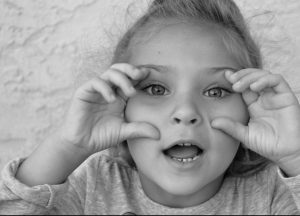After Treatment with LUXTURNA, It’s a New Year, New Vision
Two little girls – one on the East Coast and one on the West Coast – ring in this New Year with something they’ve never had before – their vision.
Eight-year-old Hannah Reif of Maple Glen, PA, and 6-year-old Monroe Le of San Diego, CA, underwent breakthrough genetic therapy surgeries to fix a mutation in their RPE65 gene, which had caused a rare inherited retinal disease (IRD) called Leber congenital amaurosis (LCA).
Dr. Albert M. Maguire performed Hannah’s surgery at Children’s Hospital of Philadelphia (CHOP) in July. Dr. Aaron Nigel performed Monroe’s surgery at Children’s Hospital of Los Angeles (CHLA) in August.
Dr. Maguire is part of the married research team that brought the genetic therapy treatment developed by Spark Therapeutics called LUXTURNA™ to fruition. Dr. Jean Bennett and Dr. Maguire researched and conducted studies working with mice and dogs, and then humans in clinical trials. They developed the first genetic therapy treatment for LCA2 (RPE65), and the first treatment in the United States for any inherited disease. The U.S. Food and Drug Administration approved it in December 2017.
Hannah had a milder form of LCA, with night blindness and poor peripheral vision. Her mother, Amy, still marvels at the idea of genetic research focusing on her daughter’s gene mutation.
Using a syringe, Dr. Maguire injected under Hannah’s left retina a human-engineered virus containing a healthy version of the gene, which supplants the mutated gene. Within 24 hours of the July 10 surgery, Hannah had increased sensitivity to light; six days later, she could see the water line in her glass, rather than sticking her finger in the glass to feel for the water. On Day 7, she saw a star for the first time; six days later she underwent surgery on her right eye.
‘She can see’
Hannah can now see everything in her environment more easily and her visual acuity has improved from 20/200 to 20/100.
Shortly after surgery, Hannah flipped on her desk lamp and was so startled by the brightness that she began to cry. Now, Hannah says, “I don’t even remember what it was like before my surgery.”
Amy and her husband, Chris, revel in their little girl playing with her horse figurines in a dark room on a cloudy day, and they say her night vision has improved a thousand-fold.
“It’s just wonderful to watch her do things and see things. She’s not saying, ‘Hey, look what I’m doing.’ She just does it. She can see.”
Her mom said most recently, she’s just discovered the blue veins under her skin and the “H” and “C” on the bathtub faucets.
Her parents and others have noticed she’s more confident in school, in church and socially with her friends. Although she still needs some supports in place at school, Hannah’s doing great in her second-grade class.
On past Christmas mornings, she’d open a gift and have to be told what it was. Not this year!
Amy also recalled Hannah walking into their church sanctuary, brightly decorated for Christmas with ribbons, greens and flowers.
“As she walked through the doors, she looked around in amazement and said in a soft, sweet voice, ‘Wow!’ ”
‘Like night and day’
Kindergartener Monroe Le underwent surgery Aug. 14 on her left eye and a week later on her right eye.
“She’s like night and day,” said her mom, Heather.
Before surgery, Monroe’s vision was 20/300 for both eyes and now it’s 20/150.
So much has changed since 2012; Heather knew something was wrong with baby Monroe at 2 weeks when she looked toward the light rather than her.
“I remember crying and saying to my husband, ‘She’s blind. She’s blind,’ and he said, ‘She’s not’ … from 2 weeks until she was diagnosed, we were knocking on doctors’ doors.”
Heather was scared to have her daughter genetically tested, but she knew it would give her answers. Doctors diagnosed Monroe with LCA shortly after she turned 4; two months later she received her RPE65 genetic diagnosis.
“Oh, I’m so happy that I did it,” Heather said. “If I hadn’t gotten that test, Monroe wouldn’t have been a candidate for LUXTURNA.”
Her daughter received help to get up to speed with motor skills, and early on met a little girl named Penny, her forever friend, who has had difficulties with speech.
“They’re amazing, they love each other so much,” Heather said. “They complemented each other so well because Monroe would help her with the talking and Penny would help her with the seeing.”
Two days after her first surgery, Monroe insisted on being the one to retrieve a cap from an ointment tube dropped on the carpet. “She covered her non-surgerized eye and found it immediately.”
In school, Monroe no longer needs special lighting and doesn’t have to sit in the front of the room. “She even has been able to play four square.”
Monroe also sees her most favorite place in the world, Disneyland, and her most favorite attraction – Pirates of the Caribbean with Capt. Jack Sparrow – in a whole new light.
“There have been numerous times in a trip there where she asks me, ‘Mama is that new, or has it always been there and I’m just seeing it for the first time?’ ”
Heather and her husband, Bruce, see a much more confident little girl who no longer needs to hold hands in dim places.
“I can’t believe it’s the same girl who was so timid and afraid to let go of my hand,” she said.


